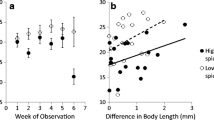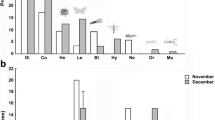Summary
Colonial web-building spiders respond to trade-offs between selective forces relative to spatial position within colonies and thus provide support for the selfish herd theory. The size distribution of spiders within colonies of Metepeira incrassata, a colonial orb-weaver (Araneae: Araneidae) from tropical Mexico is nonrandom; larger (mature) spiders and females guarding eggsacs are more prevalent in the center, whereas more small (immature) spiders are found on the periphery. Experimental field studies with spiders of selected size classes show that larger spiders actively and aggressively seek protected positions in the center of the colony webbing, even though prey availability and capture rates are significantly higher on the periphery. Attacks by predatory wasps, other spiders, and hummingbirds are more frequent on the periphery than in the core of the colony. Reproductive females on the periphery are at greater risk because they are captured more often than smaller spiders, and if their egg sacs consequently remain unguarded, chances of cocoon parasitism are increased. As a result, spiders in the core of the colony have greater reproductive success, producing more egg sacs with greater hatching frequency. Colonial spiders thus appear to be making a trade-off between foraging and protection from predation and show a spatial organization predicted by the selfish herd theory. The influence of such trade-offs on individual fitness and the structure of colonies is discussed.
Similar content being viewed by others
References
Abrahams MA, Dill LM (1989) A determination of the energetic equivalence of the risk of predation. Ecology 70:999–1007
Benton MJ, Uetz GW (1986) Variation in life-history characteristics over a clinal gradient in three populations of a communal orb-weaving spider. Oecologia 68:395–399
Cangialosi KR, Uetz GW (1987) Spacing in colonial spiders: effects of environment and experience. Ethology 76:236–246
Coulson JC (1968) Differences in the quality of birds nesting in the centre and on the edges of a colony. Nature 217:478–479
Dill LM (1987) Animal decision making and its ecological consequences: the future of aquatic ecology and behavior. Can J Zool 65:803–811
Foster SA (1989) The implications of divergence in spatial nesting patterns in the geminate Caribbean and Pacific sergeant damselfish. Anim Behav 37:465–476
Fraser DF, Huntingford FA (1986) Feeding and avoiding predation hazard: the behavioral response of the prey. Ethology 73:56–68
Gillespie RG (1987) The role of prey availability in aggregate behaviour of the orb weaving spider Tetragnatha elongata. Anim Behav 35:675–681
Gilliam JF, Fraser DF (1987) Habitat selection under predation hazard: test of a model with foraging minnows. Ecology 68:1856–1862
Gross MR, MacMillan AM (1981) Predation and the evolution of colonial nesting in bluegill sunfish (Lepomis macrochirus). Behav Ecol Sociobiol 8:163–174
Hamilton WD (1971) Geometry for the selfish herd. J Theor Biol 31:295–311
Hieber CS, Uetz GW (1990) Colony size and parasitoid load in two species of colonial Metepeira spiders from Mexico (Araneae: Araneidae). Oecologia 82:145–150
Hoogland J, Sherman PW (1976) Advantages and disadvantages of bank swallow (Riparia riparia) coloniality. Ecol Monogr 46:33–58
Horn HS (1968) The adaptive significance of colonial nesting in the Brewer's blackbird Euphagus cyanocephalus. Ecology 49:682–694
Hurlbert SH (1984) Pseudoreplication and the design of ecological field experiments. Ecol Monogr 54:187–211
Jennings T, Evans SM (1980) Influence of position in the flock and flock size on vigilance in the starling, Sturnus vulgaris. Anim Behav 28:634–635
Lubin YA (1974) Adaptive advantages and the evolution of colony formation in Cyrtophora (Araneae: Araneidae). Zool J Linn Soc 54:321–339
Lubin YA (1980) Population studies of two colonial orb-weaving spiders. Zool J Linn Soc 70:265–287
Lubin YA, Robinson MH (1982) Dispersal by swarming in a social spider. Science 216:319–321
Major P (1978) Predator-prey interactions in two schooling fishes, Caranx ignobilis and Stolephorus purpureus. Anim Behav 26:760–777
Mangel M, Clark CW (1988) Dynamic modelling in behavioral ecology. Princeton University Press, New Jersey
Milinsky M (1977) Do all members of a swarm suffer the same predation? Z Tierpsychol 45:373–378
Milinski M, Heller R (1978) Influence of a predator on the optimal foraging behavior of sticklebacks, Gasterosteus aculeatus. Nature 275:642–644
Parrish JK (1989) Re-examining the selfish herd; are central fish safer? Anim Behav 38:1048–1053
Pitcher TJ, Lang SH, Turner JA (1988) A risk-balancing trade off between foraging rewards and predation hazard in a shoaling fish. Behav Ecol Sociobiol 22:225–228
Rypstra AL (1979) Foraging flocks of spiders - a study of aggregate behavior in Crytophora citricola Forskal (Araneae: Araneidae) in West Africa. Behav Ecol Sociobiol 5:291–300
Rypstra AL (1989) Foraging success of solitary and aggregated spiders: insights into flock formation. Anim Behav 37:274–281
Sih A (1980) Optimal behavior: can foragers balance two conflicting demands? Science 210:1041–1043
Smith DR (1982) Reproductive success of solitary and communal Philoponella oweni (Araneae: Uloboridae). Behav Ecol Sociobiol 11:149–154
Spiller DA, Schoener TS (1989) Effect of a major predator on grouping of an orb-weaving spider. J Anim Ecol 58:509–523
Stamps JA (1988) Conspecific attraction and aggregation in territorial species. Am Nat 131:329–347
Stein RA, Magnuson JJ (1976) Behavioral response of a crayfish to a fish predator. Ecology 57:751–761
Tenaza R (1971) Behavior and nesting success relative to nest location in Adelie penquins (Pygoscelis adeliae). Condor 73:81–92
Uetz GW (1986) Web-building and prey capture in communal orb weavers. In: Shear WA (ed) Spiders: webs, behavior, and evolution. Stanford University Press, Stanford, pp 207–231
Uetz GW (1988a) Risk-sensitivity and foraging in colonial spiders. In: Slobodchikoff CA (ed) Ecology of social behavior. Academic Press, San Diego, pp 353–377
Uetz GW (1988b) Group foraging in colonial web-building spiders: evidence for risk-sensitivity. Behav Ecol Sociobiol 22:265–270
Uetz GW (1989) The “ricochet effect” and prey capture in colonial spiders. Oecologia 81:154–159
Uetz GW, Cangialosi KR (1986) Genetic differences in social behavior and spacing in populations of Metepeira spinipes Pickard-Cambridge (Araneae: Araneidae), a communal-territorial orb weaver. J Arachnol 14:159–174
Uetz GW, Hodge MA (1990) Influence of habitat and prey availability on spatial organization and behavior of colonial web-building spiders. Nat Geogr Res 6:22–40
Uetz GW, Kane TC, Stratton GE (1982) Variation in the social grouping tendency of a communal web-building spider. Science 217:547–549
Vollrath F (1987) Growth, foraging, and reproductive success. In: Nentwig W (ed) Ecophysiology of spiders. Springer, Berlin Heidelberg New York, pp 357–370
Werner EE, Hall DJ (1988) Ontogenetic habitat shifts in bluegill: the foraging rate-predation risk trade-off. Ecology 69:1352–1366
Werner EE, Gilliam JF, Hall DJ, Mittelbach GG (1983) An experimental test of the effects of predation risk on habitat use in fish. Ecology 64:1540–1548
Zar JH (1984) Biostatistical analysis. Prentice-Hall, Englewood Cliffs NJ
Author information
Authors and Affiliations
Additional information
Offprint requests to: G.W. Uetz
Rights and permissions
About this article
Cite this article
Rayor, L.S., Uetz, G.W. Trade-offs in foraging success and predation risk with spatial position in colonial spiders. Behav Ecol Sociobiol 27, 77–85 (1990). https://doi.org/10.1007/BF00168449
Received:
Accepted:
Issue Date:
DOI: https://doi.org/10.1007/BF00168449




